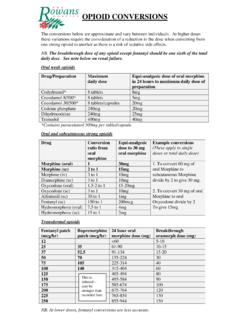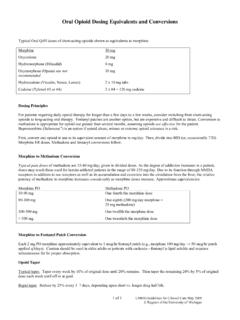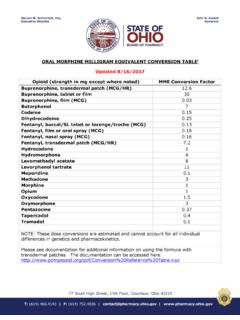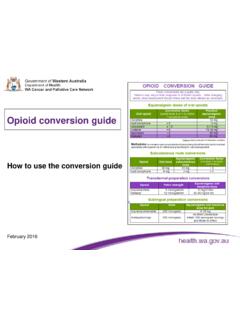Transcription of OPIOID ADMINISTRATION GUIDELINES - pedmed.org
1 439 OPIOID ADMINISTRATION GUIDELINES Reviewed by Dr. Gillian Lauder, Ms. Amanda Dalgetty (Acute, Pain Service) [APS] Dr. Jennifer Kendrick, pharmacistTABLE OF CONTENTS PAGE GENERAL GUIDELINES (for all opioids) Continuous IV 388 Breakthrough 389 Tapering and Discontinuing OPIOID 389 conversion to oral 389 General Principles of OPIOID 389 OPIOID conversion 390 SPECIFIC OPIOIDS A. Morphine 1. Writing the orders (includes example).. 390 2. Converting IV morphine to PO (includes example).. 391B. Hydromorphone 1. Writing the 392 2. Converting IV hydromorphone to 393 3.
2 Converting from morphine to hydromorphone (includes example) 394C. Fentanyl 1. Writing the 394 2. Converting from morphine to 394D. 394 MANAGING ADVERSE EFFECTS OF OPIOIDS A. Respiratory 395 B. 395 C. Nausea and 395 D. 396 E. 396 F. Altered mental 396 G. Drug 396 H. 396 I. Urinary 397 ADJUVANT DRUGS Table of non- OPIOID adjuvant 397 OPIOID ADMINISTRATION Guidelines440 GENERAL GUIDELINES FOR INTRAVENOUS ADMINISTRATION OF OPIOIDS: Delivery of an OPIOID by continuous IV infusion is the parenteral route of choice. Continuous infusions have several advantages: - no waiting between intermittent PRN doses for pain relief - a constant blood level is attained - if necessary, the blood level can be rapidly increased by giving a bolus injectionIn certain patients ( no venous access), continuous SQ infusions via a butterfly needle may be useful.
3 The dosages are the same as for continuous IV infusions, however, volume generally must be kept below 10 mL/hr (volume tolerated depends upon the size of the patient).GENERAL GUIDELINES FOR CONTINUOUS INFUSIONS OF OPIOIDS: 1. Orders must include (use order sets): a. concentration of infusion; choose from available standard concentrations as written on order sets b. dosage in microgram/kg/hr c. a dose for breakthrough pain (see below) d. the patient s weight in kg2. OPIOID infusions must be administered by an accurate infusion pump. Refer to infusion pump policies in All opioids are administered according to the C & W Child and Youth Health Policies located in The recommended dose ranges are appropriate for most patients.
4 Some patients ( intubated patients, those receiving palliative care) may require higher Patients with hepatic or renal failure require consideration for the most appropriate opioid6. Overweight and obese patients should receive doses based on a calculated drug dosing weight instead of actual body weight. Refer to the Drug Dosing Weight Normograph (see ePOPs).7. Concurrent ADMINISTRATION of sedatives or hypnotics may result in excessive sedation and/or respiratory Oral opioids should not be administered until the OPIOID infusion is stopped (unless OPIOID infusion is being weaned).9. The use of oximetry is highly recommended but should be individualized to each Use adjuvant medications whenever possible to minimize OPIOID doses and subsequent side effects (see list of adjuvant drugs).
5 Note: Acute Pain Service (APS) physicians or nurses are available for consultation if ADMINISTRATION Guidelines441 BREAKTHROUGH PAIN: 1. Use the same OPIOID for breakthrough doses ( PRN morphine boluses with a continuous morphine infusion). 2. With every infusion order, an order for a bolus dose should be written for breakthrough pain. There is a section for intermittent (bolus) dose on the pre- printed physician s orders for continuous OPIOID AND DISCONTINUING OPIOID INFUSIONS: 1. Patients with acute pain ( post-op) can usually be changed from IV OPIOID infusions to PO OPIOID and non- OPIOID Transition to oral analgesics should be started as soon as patient can retain oral fluids and pain is well Weaning (gradual decrease in infusion rate) is usually necessary.
6 The rate of weaning must be determined for each individual patient, as individual variation is high. For infusions that have been running for greater than 3 weeks, the rate of weaning will need to be extremely slow; wean at a rate of no more than 10% per d Decreasing the infusion rate too quickly will increase the risk of withdrawal effects such as jitteriness, yawning, sneezing, decreased feeding, sweating, diarrhea or unusual movements. If withdrawal symptoms occur, the dose needs to be increased and then subsequently weaned more slowly. Contact the APS for assistance when weaning opioids is Patients should be observed carefully during the transition from IV to PO opioids for signs of pain or withdrawal.
7 6. There is inter-individual variability in response to opioids, so doses need to be adjusted to individual requirements for TO ORAL OPIOIDS: Oral opioids may be started as soon as the parenteral infusion has started to be weaned. If the pain is decreasing ( post-op pain), the patient is comfortable and able to take medications by mouth, a conversion from IV to PO should be done. After doing the conversion from IV dose to PO dose, consider decreasing the PO dose by 20-30% as analgesia requirements decrease. This oral dose can be given PRN. If the pain source is constant or increasing consider adjuvant medications and consult the APS. The PO to IV conversion ratios are only estimates (see table below).
8 Some patients may require higher or lower ADMINISTRATION Guidelines442 GENERAL PRINCIPLES OF OPIOID conversion When switching from one OPIOID to another, conservative estimates must be used, especially in OPIOID -tolerant patients (those who have received opioids for approximately 7 days or more). Cross-tolerance at the OPIOID receptor may not occur and equianalgesic OPIOID dosing tables may overestimate OPIOID requirements. Morphine is subject to substantial first pass metabolism when given orally, which means that before morphine reaches the systemic circulation a substantial amount is metabolized to inactive or less active compounds. Therefore a higher dose must be given orally.
9 For the majority of patients, the conversion ratio from IV to PO is 1:3. The bioavailability of an oral dose of hydromorphone is about 60%, therefore a higher dose must be given orally. For the majority of patients, the conversion ratio from IV to PO is 1:3 Parenteral (mg)Oral (mg) APSC onsult APS1 Hydromorphone and codeine should not be used in patients with a true allergic reaction to GUIDELINES FOR CHILDREN < 3 MONTHS: Note: The ADMINISTRATION of opioids by continuous infusion in infants less than 52 weeks postmenstrual age requires continuous cardiorespiratory monitoring on designated unit. Refer to Postoperative Disposition GUIDELINES for Infants (in ePOPs). Consult Acute Pain Service (APS).
10 DOSING GUIDELINES FOR CHILDREN > 3 MONTHS: Note: These GUIDELINES do not apply to neonates, ex-premature infants and young infants (less than 3 months) as they metabolize morphine (and other opioids) more slowly, they may require modification in dosage and may be at increased risk of MORPHINE ADMINISTRATION GUIDELINES : 1. Writing the orders (Order sets are available and required for all wards outside critical care areas): a. The initial infusion rate is 5 - 40 microgram/kg/hr b. Choose from the standard concentrations available based on the patient s weight and fluid requirements. Overweight and obese patients should receive doses based on a calculated drug dosing weight instead of actual body weight.









